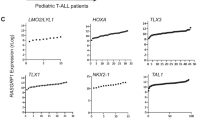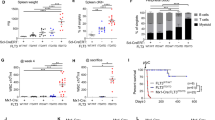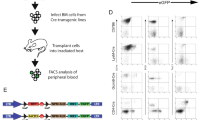Abstract
Recurrent chromosomal translocations involving the RARα locus on chromosome 17 are the hallmark of acute promyelocytic leukemia (APL). The RARα gene fuses to variable partners (PML, PLZF, NPM, NuMA and STAT5B: X genes) leading to the expression of APL-specific fusion proteins with identical RARα moieties. To analyse whether the variable X moiety could affect the activity of the fusion protein in vivo, we generated and characterized, on a comparative basis, NPM/RARα transgenic mice (TM) in which the fusion gene is expressed under the control of a human Cathepsin G (hCG) minigene. We compared the features of the leukemia observed in these TM with those in hCG-PML/RARα and hCG-PLZF/RARα TM. In all three transgenic models, leukemia developed after a variably long latency, with variable penetrance. However, the three leukemias displayed distinct cytomorphological features. hCG-NPM/RARα leukemic cells resembled monoblasts. This phenotype contrasts with what was observed in the hCG-PML/RARα TM model in which the leukemic phase was characterized by the proliferation of promyelocytic blasts. Similarly, hCG-PLZF/RARα TM displayed a different phenotype where terminally differentiated myeloid cells predominated. Importantly, the NPM/RARα oncoprotein was found to localize in the nucleolus, unlike PML/RARα and PLZF/RARα, thus possibly interfering with the normal function of NPM. Similarly to what was observed in human APL patients, we found that NPM/RARα and PML/RARα, but not PLZF/RARα leukemia, was responsive to all-trans retinoic acid (ATRA) or As2O3 treatments. Taken together, our results underscore the critical relevance of the X moiety in dictating the biology of the disease and the activity of the APL fusion oncoprotein.
This is a preview of subscription content, access via your institution
Access options
Subscribe to this journal
Receive 50 print issues and online access
$259.00 per year
only $5.18 per issue
Buy this article
- Purchase on Springer Link
- Instant access to full article PDF
Prices may be subject to local taxes which are calculated during checkout


Similar content being viewed by others
References
Alcalay M, Tiacci E, Bergomas R, Bigerna B, Venturini E, Minardi SP et al. (2005). Blood 106: 899–902.
Brunning RD, Matutes E, Flandrin G, Vardiman J, Bennett J, Head D et al. (2001) In: Jaffe ES, Harris NL, Stein H, Vardiman JW (eds), Pathology and Genetics of Tumours of Haematopoietic and Lymphoid Tissues. IARC Press: Lyon, pp 75–108.
Cheng G, Zhu X, Men X, Wang L, Huang Q, Jin X L et al. (1999). Proc Natl Acad Sci USA 96: 6318–6323.
Degos L . (2003). Br J Haematol 122: 539–553.
Dyck JA, Maul GG, Miller Jr WH, Chen JD, Kakizuka A, Evans RM . (1994). Cell 76: 333–343.
Falini B, Mecucci C, Tiacci E, Alcalay M, Rosati R, Pasqualucci L et al. (2005). N Engl J Med 352: 254–266.
Grisendi S, Bernardi R, Rossi M, Cheng K, Manova K, Khandker L et al. (2005). Nature 437: 147–153.
Grisendi S, Pandolfi PP . (2005). N Engl J Med 352: 291–292.
Grisolano JL, Wesselschmidt RL, Pelicci PG, Ley TJ . (1997). Blood 89: 376–387.
He LZ, Bhaumik M, Tribioli C, Rego EM, Ivins S, Zelent A et al. (2000). Mol Cell 6: 1131–1141.
He LZ, Guidez F, Tribioli C, Peruzzi D, Ruthardt M, Zelent A et al. (1998). Nat Genet 18: 126–135.
He LZ, Tribioli C, Rivi R, Peruzzi D, Pelicci P G, Soares V et al. (1997). Proc Natl Acad Sci USA 94: 5302–5307.
Heusel JW, Scarpati EM, Jenkins NA, Gilbert DJ, Copeland NG, Shapiro SD et al. (1993). Blood 81: 1614–1623.
Hummel JL, Zhang T, Wells RA, Kamel-Reid S . (2002). Cell Growth Differ 13: 173–183.
Kurki S, Peltonen K, Latonen L, Kiviharju TM, Ojala PM, Meek D et al. (2004). Cancer Cell 5: 465–475.
Lin H-K, Bergmann S, Pandolfi PP . (2004). Nature 431: 205–211.
Okuda M . (2002). Oncogene 21: 6170–6174.
Piazza F, Gurrieri C, Pandolfi PP . (2001). Oncogene 20: 7216–7222.
Redner RL, Chen JD, Rush EA, Li H, Pollock SL . (2000). Blood 95: 2683–2690.
Rego EM, He LZ, Warrell Jr RP, Wang ZG, Pandolfi PP . (2000). Proc Natl Acad Sci USA 97: 10173–10178.
Rego EM, Pandolfi PP . (2001). Semin Hematol 38: 54–70.
Rego EM, Wang ZG, Peruzzi D, He LZ, Cordon-Cardo C, Pandolfi PP . (2001). J Exp Med 193: 521–529.
Ruthardt M, Orleth A, Tomassoni L, Puccetti E, Riganelli D, Alcalay M et al. (1998). Oncogene 16: 1945–1953.
Sainty D, Liso V, Cantu-Rajnoldi A, Head D, Mozziconacci MJ, Arnoulet C et al. (2000). Blood 96: 1287–1296.
Sirulnik A, Melnick A, Zelent A, Licht JD . (2003). Best Pract Res Clin Haematol 17: 71–97.
Zhong S, Salomoni P, Pandolfi PP . (2000). Nat Cell Biol 2: E85–E90.
Acknowledgements
We thank the members of Pandolfi's lab for discussion, Ana Sílvia G Lima for technical assistance and Linda DiSantis for editing the manuscript. This work was supported by the National Cancer Institute and National Institutes of Health (Grant CA-74031 to P.P.P.) and Fundação de Amparo à Pesquisa do Estado de São Paulo (Grant 98/14247 to E.M.R.).
Author information
Authors and Affiliations
Corresponding author
Rights and permissions
About this article
Cite this article
Rego, E., Ruggero, D., Tribioli, C. et al. Leukemia with distinct phenotypes in transgenic mice expressing PML/RARα, PLZF/RARα or NPM/RARα. Oncogene 25, 1974–1979 (2006). https://doi.org/10.1038/sj.onc.1209216
Received:
Revised:
Accepted:
Published:
Issue Date:
DOI: https://doi.org/10.1038/sj.onc.1209216
Keywords
This article is cited by
-
Novel inhibitor of hematopoietic cell kinase as a potential therapeutic agent for acute myeloid leukemia
Cancer Immunology, Immunotherapy (2022)
-
Current views on the genetic landscape and management of variant acute promyelocytic leukemia
Biomarker Research (2021)
-
Halofuginone inhibits phosphorylation of SMAD-2 reducing angiogenesis and leukemia burden in an acute promyelocytic leukemia mouse model
Journal of Experimental & Clinical Cancer Research (2015)
-
Expression of the promyelocytic leukemia zinc-finger in T-lymphoblastic lymphoma and leukemia has strong implications for their cellular origin and greater association with initial bone marrow involvement
Modern Pathology (2012)
-
Valproic acid induces differentiation and transient tumor regression, but spares leukemia-initiating activity in mouse models of APL
Leukemia (2012)



